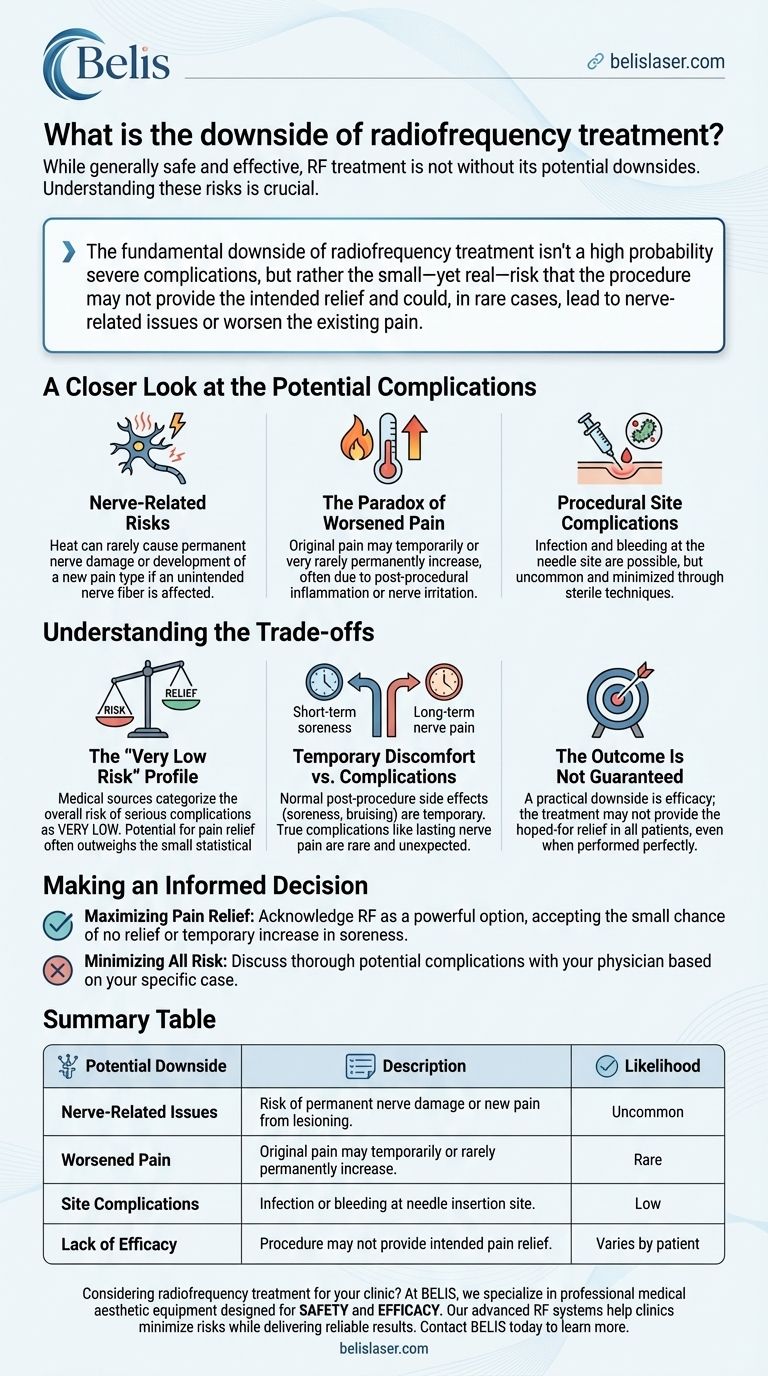While generally considered a safe and effective procedure, radiofrequency (RF) treatment is not without its potential downsides. The primary risks, though uncommon, include the possibility of permanent nerve damage, a temporary or lasting increase in the original pain, and complications like infection or bleeding at the needle insertion site.
The fundamental downside of radiofrequency treatment isn't a high probability of severe complications, but rather the small—yet real—risk that the procedure may not provide the intended relief and could, in rare cases, lead to nerve-related issues or worsen the existing pain.

A Closer Look at the Potential Complications
Understanding the specific risks allows you to have a more informed conversation with your physician. These complications are not common, but they are important to be aware of.
Nerve-Related Risks
The most significant potential downside involves the nerves themselves. The procedure uses heat to intentionally create a lesion on a nerve to block pain signals.
On occasion, this can result in permanent nerve damage or the development of a new type of pain. This typically occurs if the heat affects an unintended nerve fiber near the target area.
The Paradox of Worsened Pain
In some individuals, the original pain may temporarily or, in very rare instances, permanently worsen after the procedure.
This can be due to post-procedural inflammation and irritation of the nerve before the full numbing effect takes hold. While usually temporary, it is a key risk to consider.
Procedural Site Complications
Like any procedure that involves breaking the skin with a needle, there are inherent risks at the insertion site.
These include infection and bleeding. Such complications are uncommon and are minimized through sterile techniques and post-procedure care, but the risk is never zero.
Understanding the Trade-offs
The decision to undergo radiofrequency treatment is about weighing the potential for significant pain relief against a low probability of adverse outcomes.
The "Very Low Risk" Profile
It is critical to contextualize these downsides. Medical sources consistently categorize the overall risk of serious complications from RF ablation as very low.
For many patients suffering from chronic pain, the potential benefit of restoring function and quality of life is deemed to outweigh the small statistical risk.
Temporary Discomfort vs. Complications
It's important to distinguish between expected side effects and rare complications. It is normal to experience some soreness, bruising, or mild discomfort at the treatment site for a few days.
A complication, such as lasting nerve pain or infection, is an unexpected and undesirable outcome that occurs infrequently.
The Outcome Is Not Guaranteed
One of the most practical "downsides" is not a medical complication but one of efficacy: the treatment may not work.
Even when the procedure is performed perfectly, a certain percentage of patients will not experience the level of pain relief they hoped for. This is an essential part of managing expectations.
Making an Informed Decision About RF Treatment
Your choice should be based on your specific condition, your tolerance for risk, and a detailed discussion with your pain management specialist.
- If your primary focus is maximizing pain relief: Acknowledge that RF treatment is a powerful option, but accept the small possibility that it may not work or could cause a temporary increase in soreness.
- If your primary focus is minimizing all possible risk: Discuss these potential complications thoroughly with your physician to understand their likelihood in your specific case, as factors like the target nerve's location can influence risk.
Ultimately, a successful outcome depends on a thorough discussion with your specialist to weigh the significant potential for relief against these uncommon but important risks.
Summary Table:
| Potential Downside | Description | Likelihood |
|---|---|---|
| Nerve-Related Issues | Risk of permanent nerve damage or new pain from lesioning. | Uncommon |
| Worsened Pain | Original pain may temporarily or rarely permanently increase. | Rare |
| Site Complications | Infection or bleeding at needle insertion site. | Low |
| Lack of Efficacy | Procedure may not provide intended pain relief. | Varies by patient |
Considering radiofrequency treatment for your clinic? At BELIS, we specialize in professional medical aesthetic equipment designed for safety and efficacy. Our advanced RF systems help medical aesthetics clinics and premium beauty salons minimize risks while delivering reliable results. Let our experts guide you in selecting the right technology for your practice. Contact BELIS today to learn how our solutions can enhance your treatment outcomes and patient satisfaction.
Visual Guide

Related Products
- IPL SHR+Radio frecuency machine
- RF Microneedling Machine Micro Needle Radio Frequency Machine
- 9D 7D HIFU Vaginal RF Lifting Treatment
- RF Microneedling Machine Micro Needle Radio Frequency Machine
- 12D HIFU Machine Device for Facial HIFU Treatment
People Also Ask
- Does IPL hair removal have other benefits? Discover the Skin Rejuvenation Perks
- How does SHR hair removal work? A Gentle, In-Motion Technology for Permanent Results
- How does an RF machine work? Unlock the Science of Non-Surgical Skin Tightening
- What does radiofrequency do to your body? Understanding Thermal Effects for Safe Treatments
- What is the difference between SHR and laser hair removal? Choose the Right Method for You



















